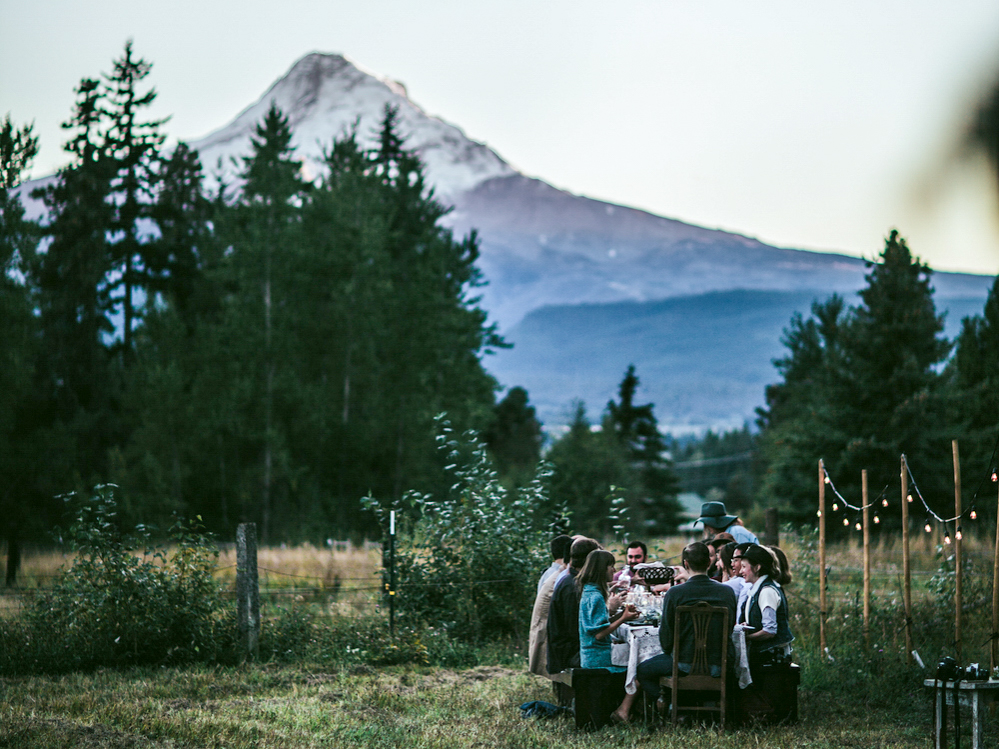Photo: Eva Kosmas Flores
Food is so much more than simply fuel for our bodies. Each meal is an opportunity to make room for more joy, pleasure, and connection in our lives. Yet so often we rush through eating while distracted with another task, completely disconnected from the source of our food and the pleasures of the experience.
The problem is as humans we are hardwired for joy. Our bodies and souls need it to thrive. Pleasure puts our bodies into a physiologic relaxation state which improves the digestion of our food, balances our appetite, and optimizes our body’s use of the nutrients we consume. So skipping the pleasure and joy in eating doesn’t help our health or happiness.
That’s why we are over the moon excited to share this article from the luminous, inspired, and downright delightful connoisseur of joyful eating–Giselle Kennedy Lord. We hope Giselle’s wisdom and contagious love of food help bring more joy, pleasure and connection to your own table and kitchen. It certainly has ours! – With love, Cara & Amber
Food is my love language, and I derive immense joy from feeding people I love. Spending hours making a meal is how I ground myself and a warm beverage (or a summer cocktail) on the porch with a friend is my idea of a perfect afternoon… Eating is about sustenance but it is also about (or at least it should be) human connection, knowledge, experience, identity, and joy. Every meal is an opportunity to find, deepen, and explore our relationship with food but also our relationships with our people, our communities, nature, culture, and ourselves.
It is worth investing in this incredibly important aspect of our life, because our nourishment is the foundation of everything else we want to be and accomplish. It is the necessary fuel to live our most inspired and meaningful life. Eating is required for life. And how we do it can shift everything.
The discovery and delight to be found in food is absolutely boundless, and the pursuit of that discovery and delight has become my greatest passion. There are countless cultural constructs around eating that strip it completely of its joy, but it’s up to each of us to reframe our unique perspective and appreciate the profound possibilities of a good meal. We can do this by approaching our relationship with food with as much intention and care as we bring into our other relationships.
Making Food A Source of Connection & Joy
If we are intentional about our food, and think of mealtimes as small, repeated rituals, we can bring so much joy into our daily lives and make special occasions all the more special. By connecting with the source of our food, staying present in the preparation, considering the meaning of our choices, and leaning in toward the people we share it with, we have at least three opportunities a day to find nourishment–not just for our bodies but also for our souls. Not just in the food itself but also in the experience of eating.
Here are 8 tips you can bring home to your table today:
1. Commit to the Relationship(s).
In thinking about your relationship with food and it’s great connection with all your other relationships, make an intention. Commit to making it a positive, joyful relationship, and to nurturing every aspect of it. If something, or some food, does not bring you joy, let it go. And for the things that do bring you joy, well, enjoy them.
In some Middle Eastern and African cultures, the entire table eats off the same plate. In China, a good business deal can only be made over a shared meal. In Argentina, you can show up unannounced at anyone’s house and they will offer you a maté (and probably some empanadas and sweets, and then they’ll invite you to stay for an asado they just decided to have… you get the idea). Recognize the opportunities to connect that food provides and find joy in that. Practice gratitude and be generous.
2. Slow your roll.
And by that I mean quite literally: slow down. It’s truly vital. Mealtime is a great opportunity to sit down and reflect, and take stock of your day and your life. Many of us live really busy lives and our meals tend to get squished into the spaces in between. Take time to think about what you’re eating and take your time eating. Think about what you are tasting, what is happening around you, what you’re looking at, and how you feel. Changing your pace will change what you eat and how you relate to it. Food and memory are quite literally connected in our brains (in complicated ways that I won’t go into here!) and we have the capacity for vivid and strong emotional responses to food. Slowing down at mealtimes will give your brain the opportunity to process positive memories and embody positive emotions.
3. Get your hands dirty.
When you connect with the growing of your food, whether it’s you or a local farmer, the way you experience that food will change. Flavor and pleasure in food is about perception, which means that any number of factors can influence that perception. I find gardening to be extraordinarily therapeutic and soul-nourishing. The pleasure of harvesting that food is beyond description. And chatting with the farmers at our saturday afternoon market who bring nourishment to my table brings me an immeasurable sense of community and grounding. By engaging with nature and the raw materials of your meals and/or the people that grow them, not only will you inevitably start to eat more nutritious food, you’ll enjoy it more too. That food will trigger all those delightful, sun-kissed garden memories and all warm, fuzzy feelings will literally make your food taste better. It’s a wonderful way to connect with people and nature, and to invite really delightful, nourishing relationships into our lives.
4. Take pleasure in the process.
Start with a single ingredient, ideally something you grew or procured from a real person, and go from there. If you’re working with food you grew or got at from a person who grew it, let your process be infused with that connection and tap into those positive associations. Eating is a sensorial experience and is unique in the way that it engages every single one of our senses. Think about it… and get sensory about it! Engaging in the tactile act of chopping, mixing, de-stemming, sauteeing, and so on makes space in your brain for consciousness and positive, restorative thoughts. Do all that in a place you feel comfortable, listening to music that makes you happy, looking out the window at your garden, smelling each ingredient along the way, and you’ve built a euphoric sensory experience for yourself. And you can keep that sensory party going when you sit down to eat! Read more about how to prepare and eat food mindfully here.
5. Set the Stage.
There’s some incredible research showing that the environment and experience we have while eating will change the taste of the food. Again, it’s about all of the senses, not just taste… How the sun pouring through your window while you sip your morning coffee makes that everyday cup even more warming. How the song sung to you by your people makes that birthday cake even sweeter. How the fireplace crackling and the tender gaze of your loved one makes your simple dinner an exquisite pleasure. How the buttered toast on that new ceramic plate handmade in Mexico is just a little tastier. Isn’t that amazing? Whether you’re at home or deciding on a place to go, think about the environmental and tactile elements of your experience and set the stage for a beautiful meal. And invite others to share in the making and the enjoying of the experience with you.
6. Listen to your body.
It’s so important to connect with yourself and your own body – listen to what your body wants and needs and make eating decisions around that. Read more about listening to and being an explorer in your own body here.
7. Redefine comfort food.
This is an extension of listening to your body. For many of us, the idea of comfort conjures up family, home, cozy spaces, warm embraces, and old sweaters. Yet somewhere along the line, indigestible gut bombs became a part of that definition. I mean, I love good biscuits and gravy every now and then, but it’s not usually what I need when I am wanting comfort. It’s just fun and delicious at the right time. Comfort is a kind of nourishment. It’s kindness, coziness, warmth, and connection. Sometimes food is a part of that–and sometimes we need something else. So next time you are wanting comfort food, I invite you to think about what ‘comfort’ means to you and how you find sustainable comfort, and not just in the context of food.
-
- Consider what your needs are for nourishment in that moment– physical, emotional, and relational. Maybe you aren’t hungry at all but lonely and could really use a warm hug from someone you care about. Or maybe you’re tired and an afternoon nap with the blanket your mom made you is exactly the kind of comfort you need. Or maybe a steaming bowl of your favorite soup when you are sick is just the thing to comfort your body and heart. Or maybe spending a Sunday making a dish that smells like your grandmother would be a wonderful way to bring the warmth and comfort of loved ones into your home.
- Make and eat foods that conjure up good feelings, positive memories, and nourishing reflections. Care for your body’s need for nutritious foods that support it in thriving. And care for your other needs with equal measures of care. Think of nourishment and comfort as complementary.
8. More joy, less guilt.
I hate the phrase ‘guilty pleasure.’ We use it a lot, and most often in reference to food. I’ve come to see it as something of an oxymoron. I’ve seen and experienced a lot of guilt associated with food. It’s a really common experience with all the mixed messages we receive around food. But there is another, more nourishing approach that focuses more on nourishment and pleasure, and less on restriction and guilt. A restricted mentality around food, or the belief that we are “cheating” can greatly detract from the incredible opportunity for joy and connection that food offers us. So here’s my proposition: let’s eat for pleasure every day, three times a day instead of focusing on guilt or restriction.
The change here is finding what truly brings you pleasure, which is more than likely the things that make your body feel good, the meals that make your soul sing, the treats that transcend, the meals shared with loved ones. Don’t deny yourselves foods that bring you pleasure that are not necessarily ‘good for you,’ but reframe how you think about them so you can actually enjoy them when you occasionally indulge. It’s just a part of the greater whole. If you go to work five days a week every week, then you should enjoy taking a day (or many) off and not feel bad about it, right? Same thing. Being intentional about eating will lead you to better eating habits and make the occasional indulgence a pleasure. Read more about Luminary’s healthful approach to whole-heartedly indulging here.
Happy eating everyone!
With Love,
Giselle
P.S. We’d love to hear from you in the comments below! What’s one of your favorite way to bring joy and pleasure to your meal times? Or what’s your greatest barrier to finding joy and pleasure in the eating experience?
Giselle Kennedy Lord is the owner of Quincho a small business focused on food, community, and culture. Giselle designs and hosts immersive workshops and events inspired by global, local, and personal gastronomic experiences and connections. Giselle spent several years producing short-form documentary films with a focus on food and agriculture. She is currently a MLA candidate in Gastronomy at Boston University. She lives in Hood River, OR, and favorite foods are tomatoes, goat cheese, and chocolate.
Follow her wonderful work and musings here: https://www.instagram.com/quinchoso/






